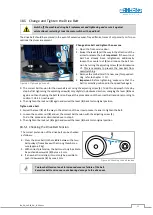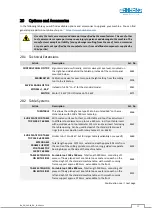
BA_PH_245-20_EN_15-22.docx
61
18.5
Change and Tighten the Drive Belt
Switch off the machine during belt replacement and tightening and secure it against
unintentional restarting! Lock the main switch with a padlock!
The drive belt should be replaced in the event of excessive wear, frayed flanks, traces of oil, porosity or if cross-
sectional fractures are present.
Figure 62: Tightening drive belt
Change drive belt and tighten the new one
1.
Open the front service door.
2.
Swivel the lever (
E
) all the way in the direction of the
arrow to release the belt.
Important:
If the worn out
belt has already been retightened, additionally
loosen the counter nut (
K
) and reduce the belt ten-
sion by turning the adjusting screw (
E
) anticlockwise
. This is necessary to prevent the new belt from
overstretching.
3.
Remove the old belt and fit a new one (for speed set-
ting, refer to chapter
4.
Important:
Before tightening, make sure that the
belt is correctly positioned in the speed fork again.
5.
The correct belt tension for the new belt is set using the adjusting screw (
S
). To do this, approach it step by
step by first tightening the adjusting screw (
S
) only slightly in clockwise direction, swinging the lever (
E
) back
again and then checking the belt tension. Repeat this procedure until the correct belt tension (according to
section
18.5.1) is achieved.
6.
Then tighten the lock nut (
K
) again and swivel the lever (
E
) back to its original position.
Tighten drive belt
1.
Swivel the lever (
E
) all the way in the direction of the arrow to make it easier to tighten the belt.
2.
Loosen the counter nut (
K
) and set the correct belt tension with the adjusting screw (
S
).
To do this, proceed as described above in step 5.
3.
Then tighten the lock nut (
K
) again and swivel the lever (
E
) back to its original position.
18.5.1
Checking the Drive Belt Tension
The correct pretension of the drive belt can be checked
as follows:
4.
Press the drive belt (in the middle between the two
belt pulleys) from above with a strong thumb pres-
sure (approx. 2 kg).
5.
With correct pretension, the belt must only be able to
be pushed downwards (
X
) by max. 5 mm.
6.
If a new belt is installed, it must only be possible to
push it downwards (
X
) by max. 2 mm.
Figure 63: Checking the belt tension
Too low belt tension leads to increased wear or failure of the belt.
Excessive belt tension can cause bearing damage to the drive axes.
K
S
E
X









































